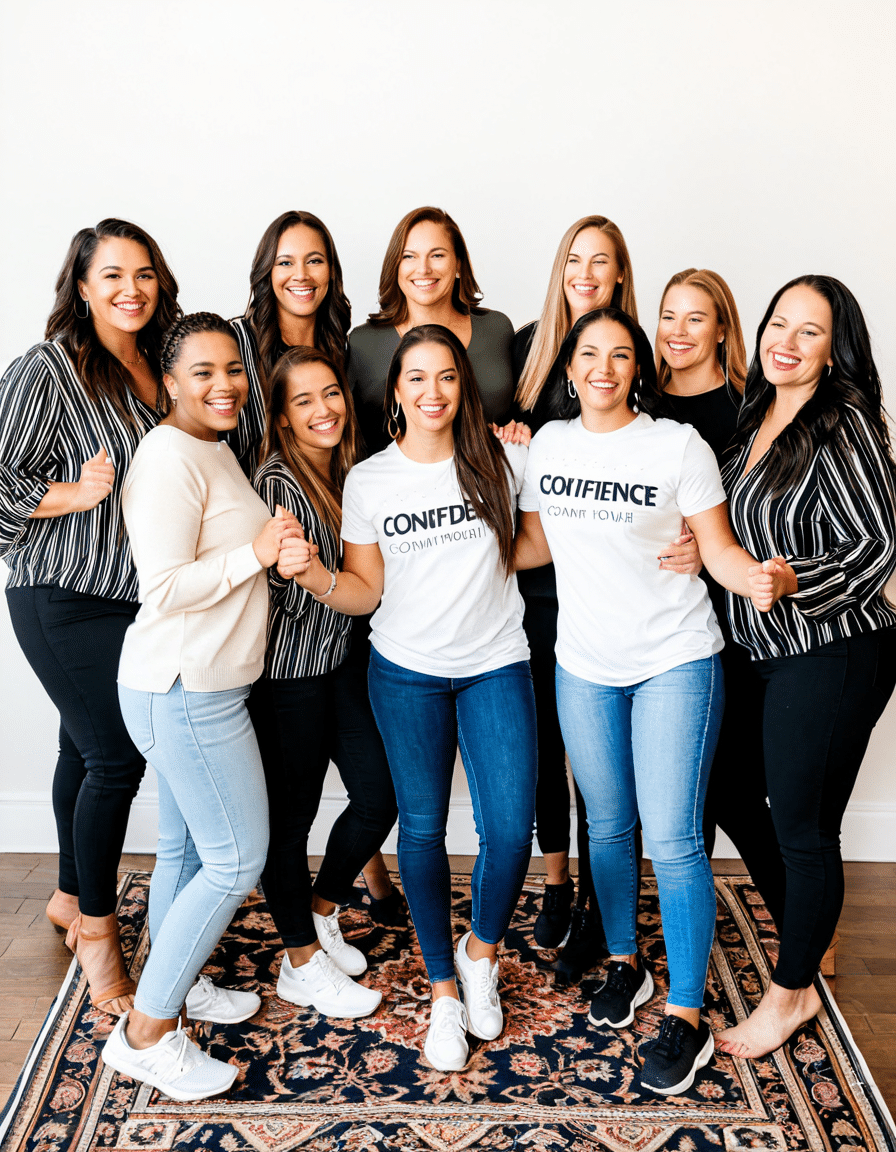Confidence training can change the course of your life, both professionally and personally. It’s not just about being a great public speaker or a top executive; it’s about developing an unwavering belief in yourself, propelling you toward your goals. Whether you’re an aspiring entrepreneur, a seasoned speaker, or someone looking to boost their workplace confidence, these transformative techniques will help you build a powerful personal brand and land the high-ticket opportunities you desire.

Top 5 Techniques in Confidence Training That Will Change Your Life
Here’s a deep dive into five proven techniques in confidence training that can elevate your self-assurance and lead you to greater success.
1. The Power of Visualization
Visualization isn’t just for athletes like Michael Phelps and Serena Williams; it’s a skill accessible to anyone, regardless of your profession. Spend a few minutes each day vividly imagining yourself achieving specific goals, whether acing a big presentation or closing a deal. This mental rehearsal helps train your brain for success. A study in the Journal of Applied Psychology found that participants who used visualization significantly boosted their self-efficacy and confidence levels.
Visualize not only the outcomes but also the steps you’ll take to reach those outcomes. Picture yourself delivering a flawless speech. Imagine hearing applause echo around you when you finish. It creates a connection between your mind and your actions. That connection can tilt your reality toward greatness.
2. Positive Affirmations
Positive affirmations are game-changers and can reshape how you view yourself. Try statements like “I am capable” or “I deserve success.” Repeating these words daily ingrains positive beliefs into your psyche. Research from the University of California supports that those who practice self-affirmation become more resilient when facing challenges.
To supercharge your affirmations, write them down and read them aloud. Engage both visual and auditory learning pathways to cement these affirmations in your mind. This dual approach not only boosts confidence but reinforces a positive self-image that can radiate in every aspect of your life.
3. Mastery Through Practice
You know what breeds confidence? Mastery! The more you practice, the more competent and self-assured you become. This technique is evident in organizations like Toastmasters International, which provides an atmosphere where members can practice public speaking in a supportive setting. Research suggests that as you regularly engage in practice, you enhance your abilities and solidify your belief in yourself.
Seek opportunities to practice your skills, whether it’s delivering presentations at your workplace or participating in workshops. The more you do it, the more you’ll believe you can. Confidence radiates from competence!
4. Embracing Vulnerability
Brené Brown’s TED talk, “The Power of Vulnerability,” emphasizes how vulnerability can act as a bedrock for confidence. Rather than shying away from your imperfections, embracing them helps build courage. Look at successful figures like Simon Sinek, who openly shares his failures to illustrate growth. Adopting a mindset that welcomes vulnerability facilitates personal strength over time.
Vulnerability is your superpower! When you step out into the world unafraid to showcase your true self, you’re more likely to connect authentically with others. True strength comes from owning who you are, imperfections and all.
5. Seeking Constructive Feedback
Feedback is a powerful tool for growth and plays a crucial role in your confidence training. Influencers like Sheryl Sandberg, former COO of Facebook, speak on the importance of seeking constructive criticism to sharpen skills. Regularly requesting feedback not only refines your abilities but reinforces your self-belief.
According to a study in the Harvard Business Review, people who actively seek feedback report much higher confidence levels. Don’t shy away from critiques; welcome them! They provide valuable insights that can propel you forward.

The Science Behind Confidence Training
The effects of confidence training aren’t mere hype; a wealth of research backs its efficacy. A meta-analysis described in Psychological Bulletin demonstrates a strong correlation between perceived self-efficacy and performance across various fields—including sales, leadership, and public speaking. When you believe you can, you achieve.
Neuro-Linguistic Programming (NLP) also plays a role in this arena. Supported by studies from the University of Arizona, NLP focuses on reshaping thought patterns, leading to an increase in self-esteem and assertiveness for those who undergo such training.
Harnessing these scientific principles can accelerate your journey toward confidence, making it more impactful and relational to your everyday interactions.

Future Trends in Confidence Training
The world of confidence training is changing. As we become more digitally connected, techniques are evolving. Virtual reality (VR) has emerged as a groundbreaking tool for simulating high-stress situations, providing users with an immersive experience that builds confidence in real-life scenarios. Companies like STRIVR lead the pack, designing programs that cater from the sports industry to corporate training.
Another exciting development is the integration of artificial intelligence in personal coaching platforms. These programs analyze speech patterns, body language, and emotional cues to offer personalized feedback, making confidence training sharper and more effective.
Stay tuned for these advancements as they shape the future of confidence training. By adapting to innovative tools, you position yourself to gain the competitive edge you crave in pitch meetings and on stage.

Building Your Confidence Pathway
Remember, building your confidence is an ongoing adventure requiring dedication and reflection. Implement these techniques consistently, and you’ll see a gradual but marked shift in your self-assurance. Life is filled with challenges, and possessing strong self-belief opens the door to innumerable opportunities.
In a world that craves confident leaders and motivating speakers, investing in your confidence is imperative. Begin your journey today, fully aware that the most profound self-assurance springs from within. Believe in yourself, practice with intention, and welcome every growth opportunity along the way. From this moment forward, transformational confidence is waiting for you!
Are you ready to take the plunge? Start today and transform your self-assurance with confidence training. You’ll not only elevate your speaking career but also your life as a whole—making each experience resonate and shine.
Explore more about using vocal clarity to strengthen your delivery by visiting Connie Pheiff ‘s workshop on vocal clarity and dive into mastering message clarity for impactful communication at Connie ‘s guide on message clarity. Unleash the power of impact speaking—discover further insights at Connie ‘s Impactful speaking resource. If you’re serious about developing your speaker brand, get started with Connie ’ s Strategies around speaker branding today!
Now is the time! Embrace your journey with open arms and build the confident you that the world deserves to see.

Confidence Training: Transform Your Self-Assurance Today
Confidence training is more than just a buzzword; it’s a game-changer in how we present ourselves. Did you know that self-assurance can actually boost your professional performance? Research shows that confident individuals often seize opportunities more readily than their less confident counterparts. In fact, one of the ways people gauge their readiness for new challenges is by looking at shifts in interest rates—like when asking are interest rates going up or down impacts financial decisions. Those who project confidence often thrive, proving that a little self-belief can go a long way.
Unpacking Confidence Training
So, what does confidence training really involve? It’s all about learning techniques that help cultivate a strong sense of self. For instance, did you know that the Homestead Act of 1862 encouraged people to build their lives on newfound confidence in land ownership? Much like stepping onto a new piece of land, confidence training helps you claim your space in any environment. Through tailored exercises and actionable insights, participants can develop a mindset that not only boosts confidence but also makes them more resilient to setbacks. And hey, speaking of engagement, just like how watching cartoons online can provide a quick laugh and a dose of nostalgia, confidence training can reinvigorate your approach to challenges!
Fun Facts and Real-World Connections
Interestingly, there are many influential people who showcase the power of confidence in their fields. For example, Alexandre Arnault has made waves in luxury retail, proving that a strong personal brand is rooted in self-assurance and charisma. Just like investing in a quality pair of Stacey Adams dress shoes can elevate your outfit, adopting confidence training principles can elevate your personal and professional presence too. Remember, confidence isn’t about perfection; it’s about progress. By integrating fun facts into your life, like discovering how a simple style upgrade can change your mindset, you can take significant steps toward becoming your best self. Who couldn’t use a little more confidence, right?

How do I train myself to be confident?
Training yourself to be confident starts with practicing positive self-talk, setting small, achievable goals, and stepping outside your comfort zone regularly. Surround yourself with supportive people who uplift you, and remember that making mistakes is part of the learning process.
What is confidence training?
Confidence training helps you develop skills, mindset, and behaviors that lead to greater self-assurance. It often involves workshops, exercises, and coaching aimed at improving your personal or professional presence and reliability.
What are the 7 types of confidence?
The seven types of confidence are social, personal, intellectual, physical, emotional, creative, and professional confidence. Each type reflects how you feel capable in different areas of your life.
How do I increase my self-confidence?
To boost your self-confidence, practice gratitude, focus on your strengths, set and achieve small goals, and challenge negative thoughts. Building a routine of self-care and surrounding yourself with positive influences can also help.
How to get extremely confident?
Getting extremely confident often means pushing your limits and facing fears head-on. Celebrate successes, learn from failures, and keep practicing skills that enhance your confidence over time.
What is the treatment for low self-esteem?
Treatment for low self-esteem typically includes therapy or counseling, journaling, practicing self-compassion, and engaging in activities that foster a sense of achievement and belonging.
What are the four P’s of confidence?
The four P’s of confidence are presence, posture, projection, and practice. These elements work together to improve how you present yourself and the way you communicate with others.
Which exercise increases confidence?
Exercises that increase confidence include public speaking practice, assertiveness training, and physical activities like yoga or martial arts which can boost your overall self-image and awareness.
Can self-confidence be taught?
Yes, self-confidence can be taught through structured programs, coaching, and practice. The key is to find methods that resonate with you and allow for gradual growth.
How to beat low confidence?
To beat low confidence, focus on small successes, get feedback from trusted friends, and challenge negative thought patterns. Engaging in activities you enjoy can also boost your mood and self-assurance.
What is the secret of confidence?
The secret of confidence often lies in knowing yourself well, setting realistic goals, and embracing failures as learning opportunities rather than setbacks.
What are the five pillars of confidence?
The five pillars of confidence include self-awareness, self-acceptance, self-assertiveness, self-regulation, and self-efficacy. Strengthening these pillars helps build a solid foundation of confidence.
How do I get 100% confidence in myself?
Achieving 100% confidence isn’t realistic, but you can work towards feeling more sure of yourself by embracing who you are and consistently practicing positive habits that promote self-belief.
Why am I losing confidence as I get older?
Losing confidence as you get older can stem from changes in life circumstances, self-perception, or physical abilities. It’s important to stay engaged, continue learning, and connect with others to maintain a sense of purpose and self-worth.
How to stop feeling bad about yourself?
To stop feeling bad about yourself, practice self-compassion and speak to yourself kindly. Focus on your strengths, engage in activities you enjoy, and reach out to supportive friends or professionals for help.
What is confidence fitness good for?
Confidence fitness is good for improving your overall self-perception, enhancing communication skills, and building resilience. It helps you push through setbacks and reinforces positive self-image.
What are the four types of confidence?
The four types of confidence are personal, social, task-related, and appearance-related confidence. Each type affects different aspects of your life and how you navigate various social or professional situations.
How does confidence coaching work?
Confidence coaching works by guiding individuals through personalized strategies and exercises that focus on building self-assurance. Coaches help identify barriers and develop actionable plans to boost confidence in specific areas.
What are the six key elements of confidence?
The six key elements of confidence are belief in yourself, self-acceptance, self-discipline, self-assertion, resilience, and optimism. Cultivating these elements helps create a more confident mindset.
Can you train self-confidence?
Yes, you can train self-confidence by practicing skills, seeking feedback, and gradually stretching your comfort zone. It’s a process that requires patience and commitment to see real change.
How to be confident as an introvert?
For introverts, being confident starts with embracing your unique qualities. Practice small talk in comfortable settings, prepare for social interactions, and remember that being quiet doesn’t mean you lack value.
How to do positive self-talk?
To do positive self-talk, replace negative inner dialogue with affirmations and encouraging statements. Focus on your achievements and strengths, and remind yourself that it’s okay to make mistakes along the way.
What’s the difference between self-esteem and confidence?
The difference between self-esteem and confidence is that self-esteem refers to how you value yourself overall, while confidence is about your belief in your ability to perform tasks or face challenges.









